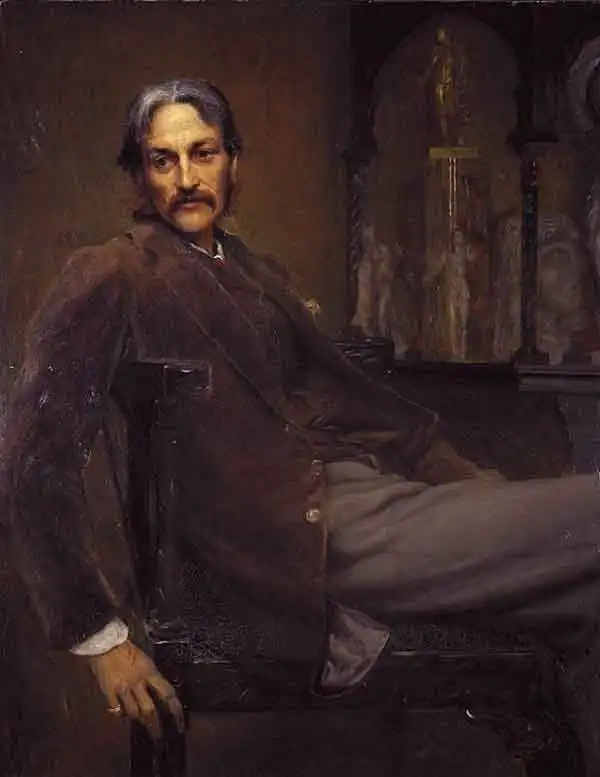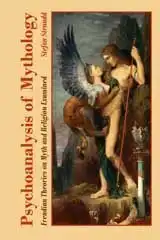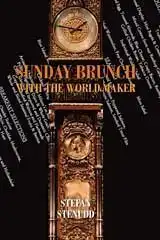Andrew Lang:
|
by Stefan Stenudd |
The 1911 Encyclopedia Britannica moves directly to mythology, the term of significantly older use, and explains that the term can be used for the study of "myths or legends of cosmogony and of gods and heroes" as well as for these legends themselves. [Andrew Lang, 'Mythology', Encyclopaedia Britannica, vol. 19, New York 1911, 128.]
It goes on to regard myth as a human search for religious explanations: "Very early indeed in the history of human thought men awoke to the consciousness that their religious stories were much in want of explanation." What confused people was the mix of the rational and the very irrational in the behavior of their gods. Especially the latter: "It is this irrational and unnatural element — as Max Müller says, 'the silly, savage and senseless element' — that makes mythology the puzzle which men have so long found it." Max Müller was a prominent Indologist in Britain, editor of the 50 volumes work Sacred Books of the East.
The above mentioned text was written by Andrew Lang (1844-1912), a Scottish folklorist and anthropologist who wrote several books about mythology and collections of fairytales. At the turn of the century he was involved in a much noticed dispute with Max Müller about the origin of the Indo-European myths and philological claims about myths in general. Lang's criticism of the philological approach to myth is extensive in his major book on the subject: Myth, Ritual & Religion [vol. 1, London 1995 (first published in 1887), 24ff.] His quote of Müller in the Encyclopedia Britannica may seem like a late peace-offering, but he has the same Müller quote in his own book [Lang 1995, 11.]
There, he discusses at length the idea that myths were formed to explain the immoral and sometimes beastly behavior of the gods. What he sees as "the essential conflict between religion and myth" [Lang 1995, 8.] is the rationality and nobility of the former versus the debasing irrationality of the latter:
Why, having attained (in whatever way) to a belief in an undying guardian, 'Master of Life,' did mankind set to work to evolve a chronique scandaleuse about Him? And why is that chronique the elaborately absurd set of legends which we find in all mythologies? [Lang 1995, 4.]
Lang's reasoning, although eloquent, is utterly based on the Christian religion as if it were the ultimate standard, and the Christian conception of God as if it were the only one plausible. That master guardian is difficult to find outside the monotheisms, and his nobility is countered by quite a lot of cruelty in the Old Testament.
In most so-called religions, there is little to suggest a benign sovereign as the world's maker and keeper. Most mythologies indicate that there is no reason to assume such a perfect being or that the world would be created by one. Instead, they suggest that the world is very much like the creatures inhabiting it, their flaws and beastly tendencies included. Deities are no exception.
So, what Lang discusses is really his own frustration with this contradiction between high deities and their lowly characteristics. As he mentions, he is not alone in this frustration.
Several of the Greek philosophers discussed it. Xenophanes complained: "Homer and Hesiod have ascribed unto the Gods all that is reproach and blame in the world of men, stealing and adultery and deceit." [J. M. Edmonds, Elegy and Iambus, vol. 1, London 1982, 201.] Pindar stated in one of his odes: "In truth it is seemly for man to say of the gods nothing ignoble; for so he giveth less cause for blame." [Sandys, John, The Odes of Pindar, Cambridge, Massachusetts 1915, 7.] He goes on to tell how "some envious neighbors" have added to the story of the gods inviting a human being, Tantalus, to join them, that they cut him up and devoured him. "Far be it from me to call any one of the blessed gods a cannibal! I stand aloof." He did not object to the idea of the gods acting mercilessly toward humans — but as punishment, well deserved, and not for some deranged pleasure of theirs.
According to Lang, Indian commentators of the Veda struggled with the same problem in their essays, which were "endeavours to put into myths felt to be irrational and impious a meaning which does not offend either piety or reason." [Lang 1995, 7.] He also claims that "most of the foulest myths of early India are absent, and presumably were left out, in the Rig-Veda." [Lang 1995, 14.] He sees this pattern repeated by the "pious and reflective" all over the world:
The explanations which men have given of their own sacred stories, the apologies for their own gods which they have been constrained to offer to themselves, were the earliest babblings of a science of mythology. [Lang 1995, 13f.]
Andrew Lang's solution to his problem is as simple as it is prejudiced. He regards it as an evolution of spiritual ideas. Myths are remnants of a primitive society to which they made sense in all their absurdity. He expresses this with the deplorable attitude sadly accepted at his time:
Our theory is, therefore, that the savage and senseless element in mythology is, for the most part, a legacy from the fancy of ancestors of the civilised races who wew4re once in an intellectual state not higher, but probably lower, than that of Australians, Bushmen, Red Indians, the lower races of South America, and other worse than barbaric peoples. [Lang 1995, 34f.]
The reason for these outdated remnants being kept in the religions, according to Long, is the reverence of the decendants, who "dared not reject the religion of their ancestors."
He is quite aware of this evoloutionary theory of sorts resembling Charles Darwin's theory: "our theory naturally attaches itself to the general system of Evolution." [Lang 1995, 39.] Lang even refers to Darwin with a quote on myth as the "miserable and indirect consequences of our highest faculties." [The quote is from Charles Darwin, The Descent of Man, and Selection in Relation to Sex, London 1871, 69. Lang 1995, 36.]
But in that passage, Darwin refers to just about all kinds of religious beliefs, explicitly including monotheism, and concludes: "they shew us what an infinite depth of gratitude we owe to the improvement of our reason, to science, and our accumulated knowledge." [Darwin 1871, 68f.]
Darwin talks about superstition and not myth. The chapter in his book is called Belief in God — Religion. It is by no means a declaration of one belief being superior to another, but discusses how beliefs of this kind at all entered the human mind.
As for the substance in the belief in a world creator, benevolent or not, Darwin mentions with what is not totally impossible to perceive as having a touch of irony:
The question is of course wholly distinct from that higher one, whether there exists a Creator and Ruler of the universe; and this has been answered in the affirmative by the highest intellects that have ever lived. [Darwin 1871, 65.]
At least, Lang has the decency not to connect his ideas of different levels of rationality in myths to "dubious theories of race." [Lang 1995, 45.] Instead, he sees the contents of myths explained by "the stage of culture attained by the people who cherish them."
Nevertheless, Lang's model is a hierarchy of myths according to their content, from a primitive to an advanced level — or with his words a development from the irrational to the rational. But myth is not a race towards some fantastic finishing line. If it were, we would surely have forgotten all those myths of old no longer fitting our ethics and reason. Nor is any society so homogenous that it can easily and adequately be placed on a certain level of civilization, especially not regarding its beliefs.
Furthermore, Lang's application of evolution suggests that it is a force working towards moral and rational improvement. But it has no goal at all. It is just a continuous adaption to circumstance with chance as its main instrument. Evolution is the survival of the fittest at the time of their lives and in the environtment of their habitat.
Some species do fine through millions of years without any major change happening to them, and others evolve comparably quickly into shapes so far from their previous existences, even Darwin would have trouble seeing the link. There is no master plan that we have noticed.
Accordingly, there is no distinct pattern of decreased primitivity in myths from the distant past to the not so distant. The Bible is a good example.
Its most ancient stories of the Old Testament are hardly any more "irrational" or alarmingly brutal than the very last text of the New Testament: Revelations. And just about all the texts of the Bible demand as much blind belief as the very oldest ones we know, such as the Pyramid Texts, Gilgamesh and Enuma Elish. The oldest of the Pyramid Texts are from c. 24th century BC. The Babylonian twelve-tablet version of Gilgamesh is from c. 1200 BC, but the story dates more than 1,000 years back from that period. Enuma Elish dates back to somewhere during the 2nd millennium BC.
Another problem with Lang's model is that it fails to show any evolution of belief, since it also states that old remnants of them are kept in the myths. So, they stay the same no matter how beliefs change. Therefore his model is of no use in trying to extract ancient versions or testing the authenticity of present ones.
All it does, as far as I can see, is to excuse the superstitions and immoralities of the myths. But that is just meaningful if we demand of myths to be rational and moral, which would simply be to demand of them not to be myths at all.
NEXT
Max Müller: Disease of Language.
Mythology Meanings Menu
- Introduction
- Mythology and Fable in the First Encyclopedia: Louis de Jaucourt
- Thomas Blackwell: Instruction by Fable
- Antoine Banier: Mythology as Idolatry
- Eusebius: Myths as Heathen Remnants
- Plutarch: Battle of Daemons
- Euhemerus: Myth as Actual History
- A Scientific Revolution of Mythology
- Andrew Lang: Rational versus Irrational
- Max Müller: Disease of Language
- Edward B. Tylor: Animism Turned Personification
- James G. Frazer: Myth as Ritual
Some of My Books:Click the image to see the book at Amazon (paid link).
The Greek philosophers and what they thought about cosmology, myth, and the gods. |
MENU
Creation Myths Around the World
How stories of the beginning began.
The Meanings of Mythology
Theories through history about myth and fable.
Archetypes in Myths
The mythological symbols and what they stand for.
The Logics of Myth
Patterns of creation.
Contact
About Cookies
CREATION MYTHS IN DEPTH
Creation in Rig Veda 10:129
The paradox of origin, according to an Indian myth.
Genesis 1
The first creation story of the bible scrutinized.
Enuma Elish
The ancient Babylonian creation myth.
Xingu Creation of Man
The insoluble solitude of gods and humans.
ON MY OTHER WEBSITES
Psychoanalysis of Myth
What Sigmund Freud and C. G. Jung thought about myths, their origins and meanings.
Myth of Creation
An introduction to the subject of creation myths and the patterns of thought they reveal.
Cosmos of the Ancients
What the Greek philosophers believed about the cosmos, their religion and their gods.
Life Energy
The many ancient and modern life force beliefs all over the world explained and compared.
Taoistic
Taoism, the ancient Chinese philosophy of life explained. Also, the complete classic text Tao Te Ching online.
 Stefan Stenudd
Stefan Stenudd
About me
I'm a Swedish author and historian of ideas, researching the thought patterns in creation myths. I've also written books about Taoism, the Tarot, and life force concepts around the world. Click the image to get to my personal website.

 Archetypes of Mythology
Archetypes of Mythology Psychoanalysis of Mythology
Psychoanalysis of Mythology Cosmos of the Ancients
Cosmos of the Ancients Life Energy Encyclopedia
Life Energy Encyclopedia Sunday Brunch with the World Maker
Sunday Brunch with the World Maker Fake Lao Tzu Quotes
Fake Lao Tzu Quotes